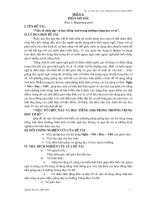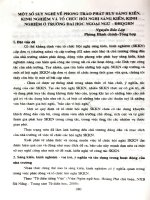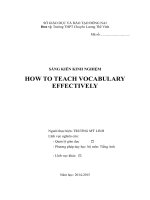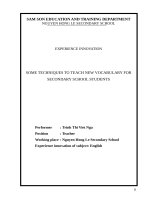(Sáng kiến kinh nghiệm) SOMETECHNIQUES TO TEACH NEW VOCABULARYFOR AECONDARY SCHOOL STUDENTS
Bạn đang xem bản rút gọn của tài liệu. Xem và tải ngay bản đầy đủ của tài liệu tại đây (583.24 KB, 22 trang )
SAM SON EDUCATION AND TRAINING DEPARTMENT
NGUYEN HONG LE SECONDARY SCHOOL
EXPERIENCE INNOVATION
SOME TECHNIQUES TO TEACH NEW VOCABULARY FOR
SECONDARY SCHOOL STUDENTS
Performer
: Trinh Thi Viet Nga
Position
: Teacher
Working place : Nguyen Hong Le Secondary School
Experience innovation of subject: English
SAM SON, 2015
TABLE OF CONTENTS
Pages
1. INTRODUCTION.......................................................................................1
2. CONTENTS.................................................................................................2
2.1. Rational.....................................................................................................2
2.2. Current state of the problem...................................................................2
2.3. Problem solving:.......................................................................................3
2.3.1 Some principles to teach new vocabulary............................................4
2.3.2. Steps for presenting new vocabulary...................................................4
2.3.3. Eleciting techniques for teaching vocabulary.....................................5
2.3.4. Checking techniques for vocabulary...................................................8
2.3.5. A model lesson plan.............................................................................13
2.4 Achivements.............................................................................................17
3. CONCLUSION..........................................................................................18
REFERENCES..............................................................................................20
1
1. INTRODUCTION
*.Reason for choosing topic.
Nowaday, English has become the common language throughout the world
and more than forty countries use it as a primary language and almost 400 million
people use it as a second language in communication. In Vietnam, English is
considered a primary language in schools today. As teachers teach subjects in
English, I always want my students to understand all the fastest, most proactive,
especially the children can apply the knowledge learned in real communication. For
this, we need to renew teaching methods so that each student in class more
interested in active learning and memory training is all right in class. We all know
any languages in the world, want to communicate with it, requires us to have a
vocabulary because the words are an indispensable component of language. In
English we can not train and develop the four skills of listening, speaking, reading
and writing of students that are not based on the foundation of vocabulary. Indeed,
without the necessary capital, they will not be able to develop good skills in
listening, speaking, reading and writing whether they have mastered the phrases
and grammar is trhuc. But mostly, the students do not understand the importance of
learning the vocabulary so lazy or just learn flower speaker and not use it. With the
amount of new knowledge that it differs far from their native language so they are
afraid of school students. Therefore the teacher must do to vocabulary no longer be
"difficulties" of students, think that every concern me forever, with some years
having no classroom many times students do not fall vocabulary , misspell,
misunderstand the question and do not translate inspired me to implement the
project "Some techniques to teach new vocabulay for secondary school students”.
*. Research purposes.
- The role of teaching vocabulary skills in teaching and learning English.
- The ability to introduce and test their vocabulary.
- The result of the use of the technique.
* Research subjects
- Students in grades 6,7,8,9
1
- Textbooks 6,7,8,9
- Workbooks 6,7,8,9
* The research methods.
- Methods of observation.
- Methodology and Practice.
- The method of synthesis.
2. CONTENTS
2.1. Rational
In any language, the role of vocabulary is very important. We can see one
language is a subset of the vocabulary. Unable to understand language without
understanding the vocabulary, or through the lexical units. But that does not
mean that only understand the individual lexical units, independent of each other
that can only be mastered through language dialectical relationship between the
lexical units. So learning the vocabulary and practice using vocabulary skills as
the leading factor in transmitting and acquiring a language in general and
English in particular. Since vocabulary is a unit of language, it is expressed in
two forms: verbal and written. Want to use the language, that is to master the
forms of expression of the oral and written language. But because there is an
association of words with other elements of language (grammar, phonetics,
intonation ...) or in specific social situations, we see the words as the "bricks"
are grammar and other language elements were referred to as "grout" to build up
into a home language.
2.2. Current state of the problem
Through the teaching process, through interschool professional activities
and through discussions with colleagues, I myself realized that learning English
situation revealed some disadvantages as following:
- For the students:
+ In general, students are "scared" and "hesitant" to learn new words, the use of
words shows many limitations such as misspellings, incorrect pronunciation,
2
inaccurate use of words, inconsistent with the context. Most of students just
have a habit of memorizing simple word or its meaning.
+ Some students just learn-by-heart to deal with writing new words on the
board, after that, they immediately forget how to use those words. Some
students try to memorize all the new words so when they face too much new
words, they will be in the fear of learning them. That is the reason why students
often do not learn anymore or study yet ineffective. The main culprit of the
above problem is that students do not know how to learn vocabulary, not to find
out an appropriate method to learn vocabulary.
- For the teacher:
+ The fact of vocabulary teaching and learning in secondary school attracts lots
of concern of English teachers. A few years ago, teachers were really
embarrassed when teaching vocabulary lessons. Dozens of words in a unit, the
the relevance between words and theme of the lesson, mood of students, even
application of the words in communication made them confused.
+ Some recent years, the movements on reforming foreign language teaching has
been implemented, teachers have been trained techniques in teaching vocabulary.
In fact, teachers have remained embarrassment in using such techniques when they
want to give a hint through furniture, to give example or to explain the word briefly
and easily to understand, particularly abstract nouns.
+ Selecting vocabulary to teach in a review lesson weighs a burden on teachers, so
they forget to make use of lessons which can review vocabulary. Incorrect
pronunciation is a sad reality for students, leading to difficulties in communication,
even changing the teacher of each subject in each academic year. I also want to
mention to previously incorrect pronunciation of a few teachers and most of students.
From the above problems, I need to spend much time on preparing documents and
finding methods to teach vocabulary, making students interested in learning
vocabulary in particular and in learning English in general.
2.3. Problem solving:
3
For a long time, teachers are familiar with the traditional teaching method
is followed books, teacher-centered lessons should the renewal of teaching
methods many teachers feel confused. Therefore, to prepare a lesson, vocabulary
or, attract students, which requires teachers to take time to explore, collect
pictures, make furniture, visual aids, bringing real objects simple ... to help
students remember in class. So teaching vocabulary with the new approach, the
most effective to ensure the following:
2.3.1. Some principles to teach new vocabulary
- In a class teacher should choose 5 -8 to teach new words, those words should
be of the type of activity (active vocabulary) This means that the students will be
practiced regular use in class, especially in speaking and writing skills.
- The words should have a higher frequency means that they appear frequently
in the text.
- These terms need to be learned in the learning process of students in the
present and the future.
- Teachers should should focus on teaching the writing system of both Vietnamese
and English. If students must learn phonetic symbol they will be confused between
writing and phonetic notation of a word.
2.3.2. Steps for presenting new vocabulary
1-Use a suitable technique to elecit or show the meaning of the new
vocabulary .
2-Model the pronunciation clearly ( 3 times )
3-Ask students to repeat the word in choral and individually.
4- Correct students’ s pronunciation
5-Write the words
on the board and students’s copy down on their
notebooks.
6- Check that students clearly understand the meaning and pronunciation.
7- Draw students’ attention to aspect of vocabulary such as part of speech,
frequency etc…..
4
8-Gives students a written record.
(May be teacher check that students write well in their vocabulary
notebooks)
2.3.3. Eleciting techniques for teaching vocabulary
True- False statements
Visuals
Realia
n
Mime
8 techniques
Synonym/
Antonym
Situation/
Explanation
Example
Translation
*Visuals
- Use a picture
- Draw on black broad
ex: A backpack
*Mime
- Face expression
- Gesture
- Body action
ex : to brush ( one’ teeth )
Teacher takes a toothbrush then brushes her teeth
T asks : “ What am I doing ?”
5
Ss: You are brushing your teeth
T: now repeat “ brush” ( 3 times))
*Realia:
- Use real things
( teacher brings clock , chair , telephone, plaster, scissors………. into the class )
*Synonym / Antonym:
- Use the questions
Ex :What’ s another word for “ holiday”?
Holiday= Vacation
What is the opposite of “ happy”?
Happy # Sad
*Translation:
Teacher: How do you say “Điểm đến” in English?
Ex : A destination
*True or False statements:
Teacher gives some statements and asks students to choose the best answer.
Ex :A air hostess
T. says:
a- Air hostess takes care of a forest
b- Air hostess often works in hospital.
c- Air hostess travels to many countries
* Example:
ex1: rice, meat, and fish are food (uncountable)
ex2: bananas, apples oranges …are fruits
6
ex3: shirts, trousers, jeans, shorts, dresses are clothes.
Ex4: beds, tables, chairs are furniture ( uncountable)
*Explaination/Situation:
Teachers must know how to combine multiple techniques to interpret the
meanings of words, but must interpret fast not to lose time
Ex: to teach the word "smile" teacher draw a face and said:
T: Look at the picture. He is smiling.
Now look at me. I’m smiling , too .“ Smile” is a
verb.
You smile when you are happy. Repeat “ smile
”
Ss: smile
T: Good. What does it mean in Vietnamese ?
Ss : mØm cêi
T : Well done
7
2.3.4. Checking techniques for vocabulary
Rub out and
Remember
Jumbled words
Bingo
Ordering
7 techniques
What and where
Matching
Slap the board
*Rub out and remember :
1-Teacher presents or elicits the vocabulary and builds up the list on the
blackboard.
2- After each word teacher puts the Vietnamese translation .
3- Teacher asks the students to copy in to their books and then close their
books .
4- Teacher rubs out the new word one at a time.
5-Each time teacher rubs out a word in English, points to the Vietnamese
translation and asks: What is this in Vietnamese ?
6- When all the Engkish words are rubbed out teacher goes through the
Vietnamese list and gets the studends to call out the English words
7- If there is time , teacher gets the students to come to the black board and
write the English words again
*Note: it helps leaners to memory new vocabulary.
8
Ex English 6-Unit 5 – A closer look 1
1……….. Painkillers
5…………..Sun cream
2………... Scissors
6…………..Walking boots
3………… Walking boots
7…………..Plaster
4…………Sleeping bag- Plaster
8………….Compass
*Slap the board:
1-Teacher puts the new words in English on the black board in bubbles –not
in a list.
2-If you want to check the understanding, put the Vieetnamese translationof
the new words or picture on the blackboard .
3- Teacher divides the class in to two teams of five or six to front of the
class.
4-Teacher chooses a student from each team and they stand at equal
distance from the blackboard.
5-Teacher calls out one of the new word in Vietnamese.
6- Two students must runs forward and slap the word in English on the board.
7- The one who slaps the correct word first is the winner. If students are
playing in teams, the win team gets a mark.
8- Then teacher asks two more students to come forward …..etc.
* Note: There are two points to remember. If you use only English, leaners
only recognize the word through listening. However if you use Vietnamese
translation or picture you can check the meaning of the new vocabulary.
Ex: English 9-Unit 5 –Period 28
Checking vocabulary: slap the board
9
crier
interactive
channel
control
benifit
remote
* What and where:
1- Teacher writes the new words in the circle on the black board not in a list.
2- When all the words are on the board , teacher asks the students to
repeat the words in circle.
3- Teacher rubs out one of the words but doesn’t rub out the circle.
4-Teacher gets the students to repeat the words including the rubbed out
words by poiting at the empty circle.
5- Teacher rubs out another word but leaves the circle.
6- Teacher points the word or empty circle, students read and have to
remember all the words.
7-Continues till the circle are empty.
8-Techer asks the students ( 6 or 8 at the time to come to bb and fill in
the circle with the correct words)
Ex: English 7 –Unit 9: Getting started
fascinating
amazing
firework
religious
Make a camp
* Note: This checking technique is good for leaners to memory the
newwords and also good for revision of vocabulary.
* Matching:
10
1- T writes the newwords in the list on the left hand side of the bb.
2- T .writes the definitions, translation or draws pictures on the right hand
side of the bb.
3- T. asks the Ss to come to the bb to match the items on the left with those
on the right by drawing a line between them.
Ex1:English 7 –Unit 2-Getting started
1. Junk food (n):
a. bệnh cúm
2. Put on weight:
b. bị cháy nắng
3. Flu (n):
c. đồ ăn nhanh, đồ ăn vặt
4. Sunburn (n):
d. dị ứng
5. Spots (n):
e. tăng cân
6. Allergy (n):
f. mụn nhọt
Ex 2: English 6– Unit 5- Getting started
1.valley
3. lake
5. island
7. mountain
2. forest
4. waterfall
6. desert
8. cave
A
E
Keys:
1- E
B
C
F
G
D
H
5. H
11
2- C
6. F
3- A
7. B
4- G
8. D
*Jumbled words:
1-T. sticks 6 flashcards with jumbled words on the bb
tnotancc
prenstreteiv
ea
cereseru
ralnatu Ss to rewrite the
ropttce
cyrecle
2-T-asks
words in the right order
3-T tells Ssthe first two groups with the right word will get two points
4-T. corrects them.
5- T. asks Ss to read again
Ex: Unit 10 –English 8-Period 61
*- Answer keys:
1- contact
3-resource
5- protect
2-representation
4- natural
6-recycle
*-Note:This cheking technique helps Ss to remember deeply the words
they’ve learned.
* Bingo:
1-T.draws box on bb and asks Ss to copy
2-T. Asks Ss to rewrite 6 newwords they’ve learnt in the box. .
A packet
A bay
Flu
A destination
Medicine
A doctor
3- T tells Ss that she/he will say some words.
4- If Ss hear the word, they cross it out.Like this:
A bay
12
5- When Ss cross out all six words, shout "Bingo".who say "Bingo" first will be
the winner.
*Note: This activities can be used to check and revise the newwords you
have introduced during the week.
*Ordering:
1-T writes the vocabulary on the board
Vocanol
situated
Island
pouring out
went swimming
overhead
2-T. have Ss to copy the words in to their exercise books.
3- T. read the phragraph aloud.
Ex: English 8 –Unit 12 –period 77
“Mrs Quyen & her husband visited many places in the USA while they
were there. First, they ....(1)...... at Waikiki Beach ..(2)....... on the Hawaiian ..
(3)..... of Oahu. There they could see the lava .(4)........ of the Kilawea .
(5).........when they flew(6)............They also saw the the head of 4 American
President carved in to the rock of the Mount Rushmore.
4-T asks Ss to compare their answer with their partner.
5-T asks Ss to give the anwers and read the text again to correct .
*Answer keys:
Volcano (5)
situated (2)
went swimming(1)
Island(3)
pouring out(4)
overhead(6)
2.3.5. A model lesson plan
Unit 6: OUR TET HOLIDAY
Period 42: Getting Started
Happy new year
I.Objectives :
By the end of the lesson, Ss will be able to
- understand the interview between the interviewer and Phong about the
Vietnamese Tet holiday.
- practise vocabulay related to “ Tet”: things, activities and practices
13
III. Teaching aids: - Cards, posters, cassette & tape.
III. Teaching steps.
Teacher ‘s activities
Warm up.
-Have Ss work in 2 groups.
- Teacher sticks the pictures of
Students’ activities
A. WARM UP.
Matching
1. Easter Day
holidays on the board and asks Ss to
2. Christmas Day
match the pictures to the words phrases
3. Thanhsgiving Day
-Give feed back.
4. New Year’s Day
Teacher sets the scene by asking Ss B. NEW LESSON
about the picture
I. Getting Started.
- What is Phong doing ? - What is the –He’s having an interview.
interview about? Holiday.
It’s about Vietnamese Tet
- Give some new words.
1. Activity 1:
* Vocabulary checking : Rub out and a. Pre - teach vocabulary:
- (to) celebrate: (translation)
rember
- (to) decorate: (translation)
- fireworks(n)
( visual)
14
- family gathering (n)
(translation)
- peach blossom(n)
(visual)
- apricot blossom(n) (visual)
- lucky money(n) ( visual)
15
Ss look at the conversation, listen to the
tape and then work in pairs to practice
the conversation.
- T asks some pairs to read the
conversation again.
b. Listen and Read:
- T asks Ss to read the conversation
again and answer the questions:
a. Do the Vietnamese celebrate Tet at
Ss work independently and decide if the
different times each year?
statements are true or false, then share
b. What should people do to celebrate Tet?
their answers with their partners.
c. Does Tim travel during Tet?
- Ss give out their answers.Ss work
2. Activity 2: T/F statements
independently and decide if the
Statements
True False
1.Phong is the first
person on the show
2.This year, Tet is in
February.
3.Tet is a quiet time of
the year.
4.Phong loves eating
lots of good
food during Tet.
5.Next, the interview
will talk to
a person from Japan.
Feedback1: 1.F, 2.F, 3.F, 4.T, 5.T
statements are true or false, then share
their answers with their partners.
- T asks Ss to work in pairs.
- Ss refers to the conversation to find the
information and fill in the blanks
3. Activity 3: Gap Fillings
.Feedback 2: 1. The end of January
2. house
- Ss match the words to the picture.
( individually)
3. flowers and plants
4. fireworks
5. great food ; lucky money
6. family gatherings
4. Activity 4: Matching
16
a.Lucky money
e.
b. swimming pool
c.peach blossom and apricot blosom
d. House decorations
e.Banh chung and banh tet
-T reads aloud and Ss repeat in chorus
f. Books
g. family gathering
h. School ground
Feedback 3: 1.b; 2.a; 3.c; 4.e; 5.h;
- Ss look at the pictures again and find 6.g; 7.f; 8.d
out the pictures relating to Tet 5. Activity 5:
holiday.
-T asks Ss to play the game
Feedback 4: 1, 2, 3, 7, 8
II. Consolidation :
T asks Ss to write down three things
or activities they like best about Tet,
Homework
using I like/love/ enjoy...’
C. HOME WORK
-Sumarize the main point of the lesson.
- Learn by heart new vocabularies.
-Give home work.
- Practice reading “Listen and read”
-Write about your Tet holiday.
- Do A.phonetics/40 (wb)
-Prepare new lesson: A closer look 1.
2.4 Achivements
Through the process of applying to the actual topic of teaching, I noticed
more and more students have academic progress:
- Students are more interested and active in all activities.
- The lessons become more lively
- Students remember almost the new word in the classroom quicly
- Their vocabulary increased remarkably.
17
- The weak students can use the vocabulary in simple sentences. The good
student can use the vocabulary in complex sentences.
Through comparison the academic performance of students in grades 7A1
where I taught, the quality before implementing the topic can be seen:
Total
pretty good
No.
%
good
No.
%
medium
No.
%
weak
No.
%
40
10
25
21
52,5
9
22,5
0
0
After applying the method of developing thematic vocabulary in each lesson
(Applying theme), the results of several test reach higher. Specifically:
Total
40
pretty good
No.
%
good
No.
%
medium
No.
%
week
No.
%
15
37,5
20
50
5
12,5
0
0
From the above results, we can see that the application of vocabulary
teaching methods promotes effectively and positively in improving the quality
of teaching and gives students a necessary vocabulary to enhance
communication skills of students.
3. CONCLUSION
Above is the teaching methods with practical teaching myself. I realize that
in the process of teaching, teachers should try to adopt a flexible approach to fit
with content and matching of students. Besides, teachers also need to skillfully
use these tips to stimulate pedagogical interest in learning of students and help
them learn the results. To promote positive good creative initiative of students in
learning, we need to organize the teaching process in a positive direction of
activity of the learner, in the process of teaching and learning, teachers are just
who transmit knowledge to students, students want better comprehend the
knowledge that, then you have to learn by their own activities. To the students,
besides a number of children seriously, have not only students at school through
the speakers, not by words etched into his mind, not reading, writing regularly,
not in that two-way so teachers should encourage and guide students actively
participate in the learning process. To meet requirements of renewal method in
18
lower secondary education, in addition to external factors such as program, time,
degree of student, professional competence of teachers. The most important
thing is the mode of organization of teachers in a lesson. To response to the
innovation of teaching methods in schools, as a teacher of foreign languages
department are eager to contribute our small part, along with teachers and peers
building new teaching methods more standard, more effective help for the
students more interested in learning languages, can learn actively, to
communicate with confidence in their own ability.
Conformation of Head
Sam Son, April 5th, 2016
I here by declare that this is my experience
innovation, not copying from other’s content
Written by
Trinh Thi Viet Nga
19
REFERENCES
1. Age education newspaper No 5 (1/11/2003).
2. Education magazine No. 43/2002.
3. Teaching English - Trainer's handbook. (Author Adrian Daff).
4. Psychology documents for secondary school students (Compiled by World
School. Published by Hanoi National University, 1998).
5. Education Law: the National Political Publishing - Ha Noi/2006
6. Document on training Legal Education in 2006 by the Department of
Education and Training of Quang Binh.
7. Regular refresher material for English teachers cycle 3 (2004-2007)
Educational Publishers.
20









